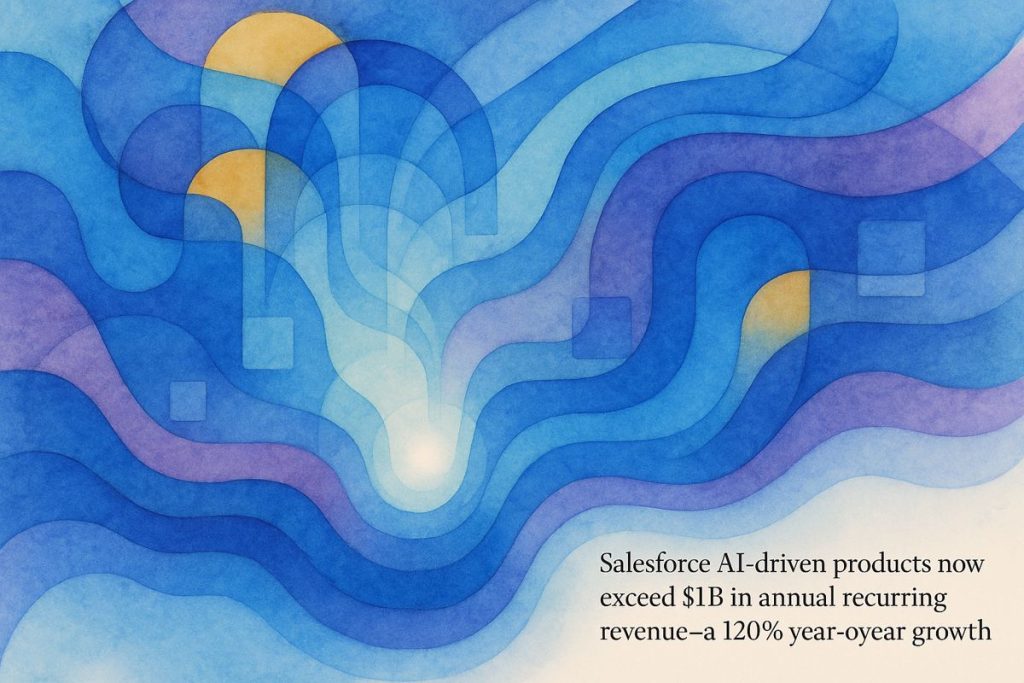Salesforce is betting big on being the top choice for businesses that want to use AI and data together.
Salesforce started 2026 strong, with $9.8 billion in revenue and big growth in AI tools like Agentforce. They bought Informatica for $8 billion to boost their data and AI powers even more. Their new Agentforce platform lets people easily build smart AI helpers for work. The company is making lots of money, and more than half of it now comes from outside the U.S. Salesforce is betting big on being the top choice for businesses that want to use AI and data together.
What were the key highlights of Salesforce’s Q1 FY26 earnings report?
Salesforce’s Q1 FY26 earnings featured $9.8 billion in revenue (up 8% year-over-year), a 19.8% GAAP operating margin, and $6.3 billion in free cash flow. Major developments included rapid AI growth with Agentforce and the $8 billion Informatica acquisition, strengthening Salesforce’s AI and data platform capabilities.
Opening the Books: The Quarter in Numbers
Salesforce has kicked off fiscal year 2026 with a report card that would make even the sternest boardroom paladin raise an eyebrow—perhaps even two. The numbers? They’re not just good; they’re a kind of low-key symphony. For the quarter ending April 2025, revenue clocked in at $9.8 billion, which represents an 8% hike over last year’s same stretch (source). Subscription and support revenue alone ballooned to $9.3 billion—a figure that makes you wonder if, somewhere deep in the bowels of their San Francisco headquarters, there’s a gold-plated espresso machine quietly whirring 24/7.
There’s more. Salesforce’s current remaining performance obligation (a.k.a. cRPO, because business loves its acronyms) reached $29.6 billion, up 12% year-over-year. That’s not just a number; it’s a drumbeat, a sign that customers are betting long on Salesforce’s evolving cloud menagerie. Still, I paused for a moment. Is this growth sustainable, or are we glimpsing a mirage shimmering on the digital savannah? I’ve made the mistake before—once, during the wild SaaS expansion of 2018, I got swept up in a similar revenue surge only to watch a key client pivot away three months later. Lesson learned: always keep one skeptical eyebrow raised.
Margins also got a polish. GAAP operating margin hit 19.8%, while the non-GAAP flavor reached 32.3%. Free cash flow? $6.3 billion, up by 4%. The company even found time to return $3.1 billion to shareholders, via dividends and share buybacks (source). If that doesn’t suggest financial discipline, well, my morning coffee’s probably decaf.
Agentforce: Salesforce’s AI Palimpsest
The serious buzz, though, isn’t just about numbers. It’s about Agentforce—the company’s bold new AI platform, engineered as a kind of hyperspectral lens for enterprise workflows. “Unified” is the word Salesforce likes to use, but conjure instead the idea of a vast switchboard, where agents, data, apps, and metadata are all cross-wired and humming in electric synchrony.
What’s under the hood? Start with Agent Builder—a low-code, AI-driven toolkit that lets even the most code-averse marketer spin up custom agents with little more than a prompt and a prayer (source). The platform wrangles reasoning engines, learning algorithms, orchestration frameworks, and governance tools like some celestial conductor. And yes, it plugs into Salesforce’s existing data, APIs, and business logic like a hand into a well-worn glove. One could almost smell the ozone of innovation—or maybe that’s just the faint tang of burning laptop plastic after a marathon hackathon.
The numbers here are striking: Salesforce’s AI products (think Data Cloud, Agentforce) are now pulling in over $1 billion in annual recurring revenue, a leap of 120% from a year ago. I had to stop and ask myself—are we at the edge of a new Cambrian explosion of digital labor, or will the hype fade like so many overcooked demos? Still, hope (and caffeine) springs eternal.
I’ll admit, I once tried building a chatbot on a Salesforce prototype and ended up accidentally spamming my own inbox for hours. Mild embarrassment, but—aha!—a reminder that even the brightest tools have rough edges.
Informatica Acquisition: Data’s New Constellation
If Agentforce is the brush, Informatica is the canvas—or perhaps more precisely, the hidden scaffolding behind the gallery wall. Salesforce’s $8 billion acquisition of Informatica isn’t just headline fodder; it’s a tectonic move in enterprise data integration. Informatica’s mastery of master data management (MDM) and ETL (extract, transform, load) is the sort of arcane alchemy that keeps digital transformation humming quietly under the surface.
Marc Benioff, Salesforce’s exuberant CEO, called it a union of “the industry’s leading AI CRM and AI-powered MDM and ETL platform to create the most complete, intelligent AI and data platform for the enterprise” (source). Whether that’s poetic license or strategic prophecy, the intent is clear: Salesforce wants to own the ADAM stack—Agents, Data, Applications, Metadata—a palimpsest upon which the future of business will be scribbled.
There’s an international flavor, too. Sixty percent of Salesforce’s revenue now comes from outside the U.S., and analysts are already penciling in a $300 million boost in 2026 thanks to currency tailwinds. I’m reminded of a time when I tried to reconcile data flows across three continents for a global client—let’s just say Informatica
